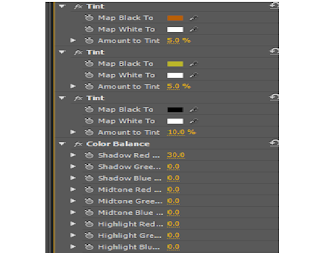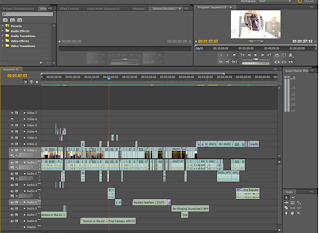With the ever integrating forms of media available in the commercial world, it was important for us as media students to grasp as many opportunities as possible to develop our skills; and ultimately create a more dynamic and professional piece of work. With a basic knowledge of the technologies available (AS year) we could experiment with a higher level of equipment and techniques. This can be seen through all stages of production; however it is most visible in the actual construction of the products because there was a lot of chance to experiment with camera techniques (the French tilt), and use the editing facilities to an optimum level (the matrix effect in After Effect and use of colour correction and sound editing in adobe Premier).
Research
First of all we analysed our previous work (from AS year) to gain a perspective on were we were up to in terms of skills, and what we needed to improve on.
Below is the opening sequence to the film 'Gemini', which was our main product for last year's coursework:
After looking at the piece in detail, we found some aspects of the opening which could have been ehanced by our more experienced selves, and we took these points on board when completing our A2 Media piece. Aspects such as the colour correction which in our AS production we only used in a limited manner, the soundtrack is a little distorted by the lack of post-production effects, apart from the credit sequence there is no other use of AfterEffects - these are the elemts which I believe we heavily improved on.
Other research:
'Alone' by Larry Molly
This short ('Alone') is a fantastic piece of coursework because the audience are given small clues as to the story-line of the film, but never really explicitly told. The use of artistic shots throughout the piece is also worthy of note as it increases the tension and mystery surrounding the young child's character. Using the website (YouTube) we were able to research pieces like this which were inspirational in themsleves. We wanted to en-corporate this idea of hidden messages into our use of the thriller genre as we also strived to unravel the narrative slowly, and with caturvating suspense.
'Networked' by Jack Thompson
This short ('Networked') uses suspense in a similar way to 'Alone'. The concept of the film itself is strong because it takes the idea of what everyone in the modern era takes for granted (the protective shield of the internet) and turns it into a very real and sinister form. We use a similiar idea in the respect that we take the protection of a dream state and use it to question how is may corrupt, or even push a person to murder.
Below we illustrate the use of different new media that technology we employed to complete the product and ancillary products of the short film 'Purgatory' in the time frame required:
Video Editing
The post-production video editing for our short film 'Purgatory' was predominately completed through the adobe software called 'Premire'. Below is the video commentary (part one) which comments on the use of this software throughout the short film:
Below is part two of the above video commentary (use of adobe Premire):
Below is a video of us editing in Adobe Premire to create the final product:
The video above shows how we just the technique of colour correction to match the suspensful tone of the film. As shown in the video, we used tints of black and white/ light blue, and the brightness and contrast tool to create the appropriate visual style. It is important to note how we copy and pasted the exact tone of each colour onto the next piece of footage to retain a consistant aesthetic throughout the film.
Below are some snap shots of editing techniques used in the Premire editing:

The snap shots on the left shows the colour correction editing technique in use. This particular piece of video is when we filmed in the studio for the psychiartrist section of the video. As shown in the image we tinted the shot with black and white to create a uncomfortable tone to this scene. This was done for the purpose of creating an atmosphere which was unnatural and distant from the seemingly "friendly" setting. On top of this, we also used a yellow and orange tint on these particular shots to give the scene a sense of artifical comfort. The tints gave the ability to make the scene look almost how it is supposed to, but at the same time strip it from natural warmth.
The snap shot on the left also shows the colour correction tool in use. In this scene (unlike the studio shots) we wanted to visually enhance the concept that this was a flashback by draining the scene of colour and adding tints to give the scene a trance-like atmosphere. For this (as shown on the left) we initially used a black and white tint to remove the shots of colour. Then we washed the individual shots with a light blue tint which gave it this "trance-like" quality. We thought this was an effective use of the media available as we were able to heighten the scene's visual style, and therefore aird the entire film to look more professional.
The snap shot on the left shows the use of the colour correction tool in another scene. In post-production we found that this scene looked a little grainy, so this particular scene lent itself quite heavily to Premire. The four grids on the left show how we adjusted the colour and noise of the shots to maximise on a sense of realism.

The snap shot on the right shows use of the transition effect on a shot in the film. Here a dip to white is used alongside a cross-dissolve to optimise on the image that Johnny is having his breakdown. This visual enhancment heightens the tension of the climactic moment as it seems as though he is of 'two minds'.
The snap shot on the left show the transistion from the studio scene to the business scene. We increased the time of this transistion so that the scene change was more obvious. We also put a dissolve effect at the end of this so that it would run more smoothly.
The snap shot on the right shows how the sound levels were contolled to enhace the video overall. We key-framed the main music track so that it became gradually louder when it started. This was also done in reverse at the end to create a continuatious effect threoughtout the piece, which was in turn heighten the overall sense of realism.
The snap shot on the left shows how sound effects were adjusted in post-production to create the on-screen atmosphere we intended. This last scene was probably the most challenging sound-wise as we had to co-ordinate the echos of the psychatrists voice (previous scene) with the diegetic sound on the next next scene, and then gradually introduce the ending soundtrack so the first lyrics of the song would begin at the start of the credits.
The image on the left shows how we used the technolgy of Adobe Premire to compress and export our final edit. This process took around three hours to complete as we tried to retain the highest resloution possible. Once the exporting was complete we were able to watch the piece in QuickTime and WindowsMediaPlayer to see if it ran smoothly. Once we were satisfied with all aspects of the production we then imported the file onto YouTube so we could obtain audience feedback.
The snap shot on the left and below illustrate the final product having been uploaded onto YouTube. This was a fantastic method of gaining audience feedback as it was accessible on a world-wide scale. Having gained the feedback we have now also gained objective opinions on what the strengths and weaknesses of the piece may have been. This will hopefully lead to even more improvements when using these forms of technology in the future, and increase our chances of success in this industry.

After Effects:
Below is a commentary to our coursework in terms of the use of after effects why we have used it and process went though to achieve the final product.
Below is and interview about the after effects process:
Our original title was "The Inner Crossover" however, after research and discussion we felt that the title was too long and un-intriguing for our target audience therefore we changed it to Purgatory.
To achieve this title sequence was fairly simple after watching various beginners after effects tutorials. Here is an example of one which was very helpful to us as it acted as a step by step guide:
Below is an example of the Matrix Effect technology being put to use in our final product:
There were many forms of technology used during the research and planning stages of our coursework. We used Blogger to document what we found from our research such as conventions of our chosen genre, audience feedback and analysis of existing media products. Blogger was helpful as it enabled us to keep track of our work and spot common trends that we could incorporate into our own products. We used websites such as YouTube, Virgin Media Shorts, and Short of the Week which were key resources when looking at existing short films of a similar genre to ours. Google was important when it came to researching existing film posters. We could identify typical colours, fonts, codes and conventions etc. used in current psychological thriller posters such as Memento and Se7en. These technologies enabled us to create realistic and professional-looking final products.
Photoshop
Adobe Photoshop has been incredibly useful throughout the production of our coursework as it was used to produce the poster. Photoshop enabled us to manipulate images and text and adjust the colour and lighting to acquire the final result that we wanted. It was very simple for us to modify the brightness and contrast of the image to achieve the right look and feel of the poster. Altering the size and scale of the image was made easy by using the resize and crop tools. The magic wand tool allowed us to cover up any imperfections on our images such as blemishes and shadows, this enabled is to get a more professional-looking image. By using different combinations of tool such as lighting and masking options, we were able to get our desired effect on our main image. The editing options that Photoshop offers are superb and they helped us to produce a realistic and professional-looking film poster.
Facebook
We received audience feedback by uploading our products to Facebook and asking our friends to give their opinions on the piece. The criticisms we received enabled us to alter our products to make them more successful.
We received audience feedback by uploading our products to Facebook and asking our friends to give their opinions on the piece. The criticisms we received enabled us to alter our products to make them more successful.












































